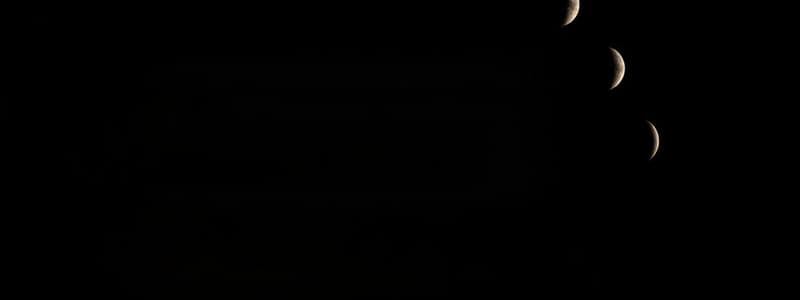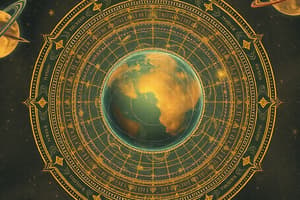Podcast
Questions and Answers
What is the main cause of day and night on Earth?
What is the main cause of day and night on Earth?
- The Moon's rotation
- Earth's rotation on its axis (correct)
- Earth's revolution around the Sun
- The Sun's position in the sky
A solar eclipse occurs when the Earth blocks sunlight from reaching the Moon.
A solar eclipse occurs when the Earth blocks sunlight from reaching the Moon.
False (B)
Name the gas giant planet that has a prominent ring system.
Name the gas giant planet that has a prominent ring system.
Saturn
When Earth orbits the Sun, it causes the changing of the _____ throughout the year.
When Earth orbits the Sun, it causes the changing of the _____ throughout the year.
Match the following phases of the moon with their descriptions:
Match the following phases of the moon with their descriptions:
Which planet is known as the Red Planet?
Which planet is known as the Red Planet?
The core of the Sun is where fusion occurs.
The core of the Sun is where fusion occurs.
What phenomenon occurs when the Sun, Earth, and Moon align?
What phenomenon occurs when the Sun, Earth, and Moon align?
Which of the following describes a solar eclipse?
Which of the following describes a solar eclipse?
The James Webb Telescope is primarily used for studying the Sun.
The James Webb Telescope is primarily used for studying the Sun.
What is the process called in which hydrogen converts into helium in stars?
What is the process called in which hydrogen converts into helium in stars?
The distance from Earth to the Sun is measured in __________.
The distance from Earth to the Sun is measured in __________.
Match the following planets with their characteristics:
Match the following planets with their characteristics:
What term refers to the phase when the Moon is between Earth and the Sun?
What term refers to the phase when the Moon is between Earth and the Sun?
The core of the Sun is the hottest layer where fusion occurs.
The core of the Sun is the hottest layer where fusion occurs.
What is the phenomenon known as when the Earth blocks sunlight from reaching the Moon?
What is the phenomenon known as when the Earth blocks sunlight from reaching the Moon?
__________ are objects in space that have a tail when near the Sun.
__________ are objects in space that have a tail when near the Sun.
Which term describes the study of the universe's origins and structure?
Which term describes the study of the universe's origins and structure?
Flashcards
Earth's Rotation
Earth's Rotation
The spinning of Earth on its axis, resulting in a 24-hour day-night cycle.
Earth's Revolution
Earth's Revolution
The journey of Earth around the Sun, taking approximately 365 days, causing the seasons.
Earth's Axis Tilt
Earth's Axis Tilt
The tilted imaginary line that Earth spins on, responsible for the variation in seasons.
Solar Eclipse
Solar Eclipse
Signup and view all the flashcards
Lunar Eclipse
Lunar Eclipse
Signup and view all the flashcards
Sun's Core
Sun's Core
Signup and view all the flashcards
Solar Flare
Solar Flare
Signup and view all the flashcards
Solar Prominence
Solar Prominence
Signup and view all the flashcards
Astronomical Unit (AU)
Astronomical Unit (AU)
Signup and view all the flashcards
Asteroid
Asteroid
Signup and view all the flashcards
Asteroid Belt
Asteroid Belt
Signup and view all the flashcards
Astronomy
Astronomy
Signup and view all the flashcards
Moon
Moon
Signup and view all the flashcards
Orbit
Orbit
Signup and view all the flashcards
Photosphere
Photosphere
Signup and view all the flashcards
Planet
Planet
Signup and view all the flashcards
Corona
Corona
Signup and view all the flashcards
Comet
Comet
Signup and view all the flashcards
Study Notes
Planetary Motion
- Earth rotates on its axis, causing day and night.
- Earth revolves around the Sun, causing the seasons.
- Earth's axis is tilted, causing varying seasons.
Moon Phases
- New Moon: Moon is between Earth and Sun, no visible light.
- Waxing Crescent: A small sliver of light is visible, growing larger.
- First Quarter: Half the moon is illuminated.
- Waxing Gibbous: More than half the moon is illuminated, nearing full.
- Full Moon: Entire surface of the moon is illuminated.
- Waning Gibbous: Light from the full moon begins to shrink.
- Last Quarter: Half the moon is illuminated, opposite the First Quarter.
- Waning Crescent: Only a small sliver of light is visible, decreasing.
Eclipses
- Solar Eclipse: The Moon blocks the Sun's light, casting a shadow on Earth.
- Lunar Eclipse: Earth blocks sunlight from reaching the Moon.
The Planets
- Order: Mercury, Venus, Earth, Mars, Jupiter, Saturn, Uranus, Neptune (MVEMJSUN).
- Planets have diverse characteristics: size, composition, atmosphere.
- Earth is habitable.
- Mars has the largest volcano.
- Jupiter is a gas giant.
- Saturn has rings.
Effects of the Sun on Earth
- The Sun provides energy for all life on Earth.
- Plants use sunlight for photosynthesis.
- The Sun's gravity keeps Earth in orbit.
- UV radiation is harmful but helps produce vitamin D.
- Solar energy is harnessed from the Sun.
- Seasons are caused by the Sun's position relative to Earth's tilt.
- Eclipses occur when the Sun, Earth, and Moon align.
Structure of the Sun
- Core: Center of the Sun, where nuclear fusion occurs.
- Gases: Hot gases rise and cool in the Sun.
- Photosphere: Visible surface layer of the Sun.
- Chromosphere: Reddish layer above the photosphere.
- Flares and Prominences: Explosive events on the Sun.
- Corona: Outer atmosphere of the Sun.
Other Objects in the Universe
- Moons: Natural satellites of planets.
- Artificial Satellites: Man-made objects orbiting planets or celestial bodies.
- Meteoroids: Small rocks in space.
- Meteors: Meteoroids burning up in Earth's atmosphere.
- Meteorites: Meteors that land on Earth.
The Big Bang
- The universe originated from a tiny, hot, dense point and expanded over time (approximately 15 billion years ago).
The James Webb Telescope
- A powerful space telescope providing detailed images of distant parts of the universe.
Terminology
- Astronomical Unit (AU): Distance from Earth to the Sun (approximately 93 million miles).
- Asteroid: Rocky body, primarily found in the asteroid belt.
- Asteroid Belt: Region between Mars and Jupiter containing numerous asteroids.
- Astronomy: Study of stars, planets, and space.
- Aurora Borealis: Northern Lights.
- Axis: Imaginary line Earth rotates on.
- Galaxy: Large collection of stars, planets, and other objects.
- Big Bang: Universe's origin from a single point.
- Chromosphere: Sun's layer above the photosphere.
- Comet: Icy body with a tail, originating from outer solar system.
- Constellation: Group of stars forming a recognizable pattern.
- Core: Sun's central, hottest region.
- Corona: Outermost layer of the Sun's atmosphere.
- Cosmology: Study of the universe's origins and structure.
- Crater: Hole formed by a meteoroid impact.
- Crescent: Moon phase showing a less-than-half illuminated portion.
- Eclipse: Occurs when one celestial body blocks another.
- Fusion: Process transforming hydrogen into helium in stars.
- Galileo Galilei: Scientist known for improving the telescope.
- Geocentric: Earth-centered model of the universe.
- Gibbous: Moon phase showing more than half illumination.
- Gravity: Force of attraction between objects.
- Heliocentric: Sun-centered model of the universe.
- International Space Station (ISS): Space station orbiting Earth.
- James Webb Telescope: Advanced space telescope for distant observations.
- Jovian Planets: Gas giants (Jupiter, Saturn, Uranus, Neptune).
- Light Year: Distance light travels in one year.
- Luminous: Emitting light.
- Meteor: Meteoroid burning in Earth's atmosphere.
- Meteorite: Meteoroid that reaches Earth's surface.
- Meteoroid: Small rock or particle in space.
- Milky Way: Our galaxy.
- Moon: Natural satellite orbiting a planet.
- Orbit: Path of a celestial body around another.
- Photosphere: Visible surface of the Sun.
- Planet: Celestial body orbiting a star.
- Polaris: North Star.
- Revolution: Earth's orbit around the Sun.
- Rotation: Earth spinning on its axis.
- Satellite: Object orbiting a planet or star.
- Solar Flare: Sudden burst of energy from the Sun.
- Solar Prominence: Large loops of gas on the Sun.
- Solar System: Sun and the objects that orbit it.
- Solar Winds: Charged particles released from the Sun.
- Star: Luminous celestial object.
- Sunspot: Dark spots on the Sun's surface.
- Universe: All that exists, encompassing all matter and energy.
- Waning: Decreasing illumination (e.g., in moon phases).
- Waxing: Increasing illumination (e.g., in moon phases).
Space Review Questions: Rotation vs Revolution
- Rotation: Earth spinning on its axis (causes day/night).
- Revolution: Earth orbiting the Sun (causes seasons).
Space Review Questions: Star Movement
- Stars appear to move from east to west.
- Polaris (North Star) remains relatively stationary.
Space Review Questions: Moon Phases
- New Moon: Moon between the Sun and Earth.
- Full Moon: Earth is between the Moon and the Sun.
Space Review Questions: Eclipses
- Solar Eclipse: Moon blocking the Sun.
- Lunar Eclipse: Earth blocking the Sun from the Moon.
Space Review Questions: Planet Characteristics
- Mercury: Closest, small, rocky planet.
- Venus: Dense atmosphere, hottest planet.
- Earth: Life-supporting planet, water, atmosphere.
- Mars: Red planet, potential for past life.
- Jupiter: Largest planet, gas giant.
- Saturn: Rings made of ice and rock.
- Uranus: Tilted axis.
- Neptune: Windiest planet.
Space Review Questions: Sun's Influence
- Advantages: Provides light, warmth, energy.
- Disadvantages: UV radiation, extreme solar flares can disrupt communication.
Space Review Questions: Sun's Cross-Section
- Core: Nuclear fusion (hydrogen to helium).
- Moving Gases: Circulation of hot gases.
- Photosphere: Visible surface.
- Chromosphere: Reddish layer above photosphere.
- Flares & Prominences: Energy bursts from Sun's surface.
- Corona: Outer atmosphere, very hot.
Space Review Questions: Comets vs. Asteroids
- Comets: Icy bodies with tails.
- Asteroids: Rocky objects.
- Asteroid Belt: Region between Mars and Jupiter.
Space Review Questions: Meteors, Meteoroids, Meteorites
- Meteoroid: Small object in space.
- Meteor: Meteoroid burning in the atmosphere.
- Meteorite: Meteoroid that strikes Earth's surface.
- Craters are formed by meteorites.
Space Review Questions: Big Bang
- The universe began as a small, dense point. Expanded over billions of years.
- Evidence: Cosmic Microwave Background Radiation and redshift of galaxies.
Studying That Suits You
Use AI to generate personalized quizzes and flashcards to suit your learning preferences.



